State report highlights opportunities to strengthen maternal health care in Washington
As May marks Women’s Health Month, maternal health care in Washington is at a pivotal moment. A recent report published by the Washington State Office of Financial Management reveals a new overall decline in the state’s birth rate, a rise in the costs of giving birth, and continued disparities in costs and access to maternal care depending on race and socioeconomic background. The findings serve as a call to action to address disparities and improve care for every mother and child in the state.
Report: Maternal Health in Washington State, 2010-2022 [PDF]
Key new findings from the report
- The number of liveborn infants per 1,000 women (aged 49 or younger) dropped by 17% between 2016 and 2022, compared to a national drop of 10% over the same period.
- Birth rates have increased for women aged 35 and older over the same period.
- More women are choosing home births or giving birth in birth centers since 2019 – they now account for around 5% of births, up from around 3.5% pre-pandemic.
- Overall pregnancy costs are rising, driven largely by labor and delivery costs.
Ongoing challenges highlighted
The report highlights disparities that persist in maternal health care access and outcomes based on race, age, education, and insurance coverage:
- Communities such as Native Hawaiian, Pacific Islander, and Black women, as well as teenagers and women with less education, or Medicaid coverage, face challenges in accessing timely and adequate prenatal care (before the baby is born.)
- Native Hawaiian and Pacific Islander women face particularly significant barriers, with many starting prenatal care after the first trimester.
- Access to postpartum care (after birth) also remains uneven, with disparities continuing to affect communities of color disproportionately.
These findings underscore the need to address the systemic inequities shaping maternal health care in Washington. Recognizing that race is a social construct, the report emphasizes that racism and structural inequities are key drivers of these disparities.
Why maternal health matters
Maternal health trends influence health care planning, resource allocation, and community well-being across the state. Rising birth rates among women 35 and older reflect evolving societal norms and highlight the importance of tailored care for higher-risk pregnancies. Meanwhile, the rising costs of care and persistent disparities underscore the urgency of advancing health equity to ensure all women, regardless of their background, can access the care they need.
A path forward to improve maternal health in Washington
The report outlines actionable steps to improve maternal health outcomes and eliminate disparities, including:
- Expanding access to quality prenatal, delivery, and postpartum care while better measuring the quality of care.
- Building power-sharing relationships with Black, Indigenous, and People of Color (BIPOC) communities and supporting community-led initiatives to promote health equity.
- Strengthening data collection, with a focus on community-level and disaggregated race/ethnicity data, to inform targeted interventions.
- Adopting a lifelong approach to women’s health, integrating preventive care and continuous support.
- Empowering women to choose their preferred birthing settings and ensuring the necessary support for their choices.
Media kit
A media kit with key data findings in the report, as well as a list of maternal health experts available to speak on the topic is available at:



